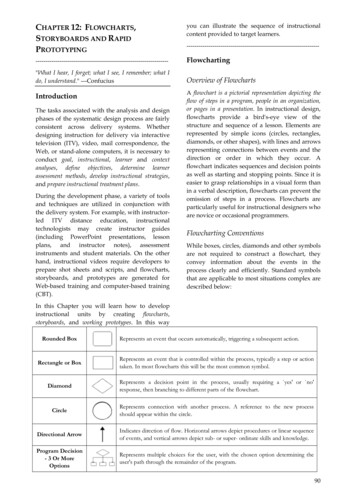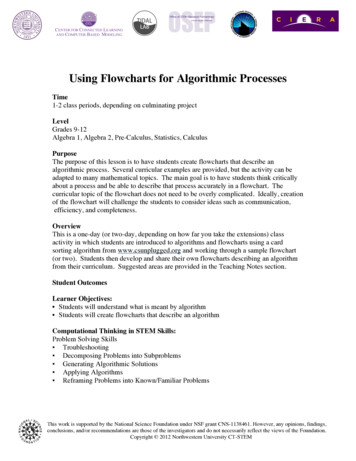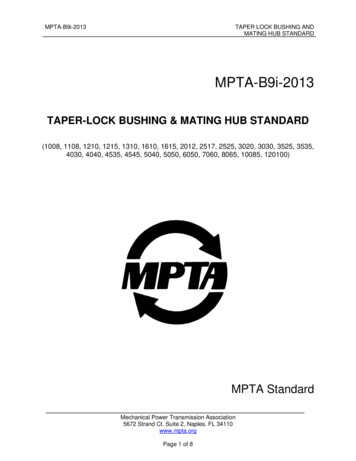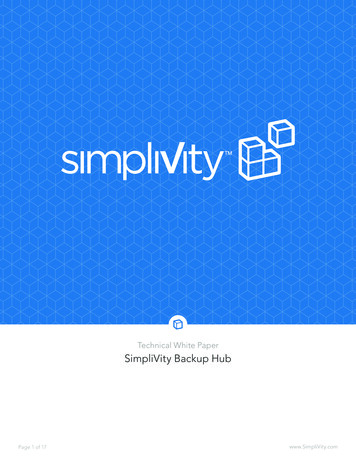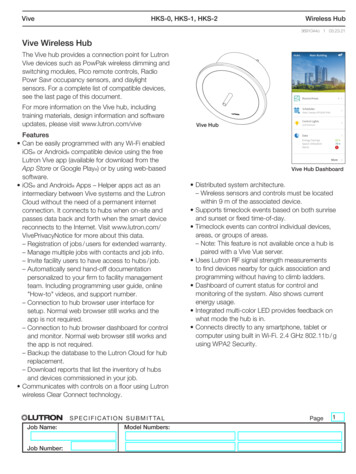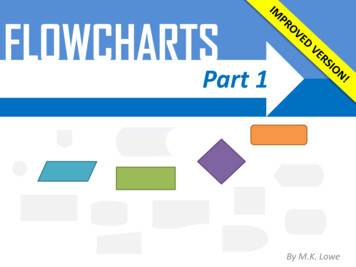
Transcription
FLOWCHARTSPart 1By M.K. Lowe
What is a flowchart? A flowchart is a way of visually representing an algorithm. An algorithm is a set of instructions or processes.Flowcharts are strict. This is because computers need SPECIFICinstructions. We decompose large problems into smallerproblems to form the instructions.Each flowchart shape contains one SMALL part of the wholeproblem. We do not over-fill flowchart shapes with essay lengthinstructions.
Basic shapesThese flowchart shapes are internationally recognised, so wemust use them and NOT invent our own ones!Terminator; This either contains START or END, and only oneof each exists in a flowchart. They specify where the startand end of a flowchart is.Input/output; We use this shape to show that something isgoing IN or OUT of the system we are designing. Forexample, we put a tea bag into a cup.Process; We use this to show that something is happening.So, if I was to walk five steps forward, that is a process. Itcan't be an output or input as nothing is going in or out!Decision; Decisions are used when we need to make achoice. Decisions MUST have two exits, one labelled YES andone NO. They are the only shape that has two exits. Forexample, “Is the kettle boiled?” This is either a YES or a NO
How to draw flowchartsMost office products have shapesyou can use in the insert menus (seescreenshot to the left). Rememberyou can use lines to connect theshapes together.Some good websites exist such as:www.draw.io
Example 1 - Getting a book out of a backpack.StartOpen zipRemove bookfrom bagEnd
Example 1 - Getting a book out of a backpack. ExplainedStartOpen zipI start all flowcharts with theTERMINATOR symbol. It only evercontains the word “START”.Notice how the FLOW of logic isrepresented by arrows the logic hereis going FROM ‘Start’ TO ‘Open zip’.Opening the zip is a PROCESS, so I usethe square here.Remove bookfrom bagEndRemoving the book is an OUTPUT fromthe system, so it uses theparallelogram shape.I finish all flowcharts with the TERMINATORsymbol. It only ever contains the word “END”.Remember I only have one of these in aflowchart. All routes must end up here!
Example 2 – Determine if I have picked up a red pencil.StartPick up a randompencilSay “Thepencil is red.”YesIs thepencilred?NoEndSay “The pencilis not red.”
Example 2 – Determine if I have picked up a red pencil. ExplainedNoticehow decision boxes have two arrowsStartleaving. One is always YES and one is always NO.They correspond to the route that should betaken depending upon the decision.Pick up a randompencilIf the pencil was red in my decision so“YES; it was red” then I follow the YES pathout of the decision and end up here!Say “Thepencil is red.”YesIs thepencilred?NoI cannot assume what colour the pencilis, so I must start be making adecision is it RED? YES or NO?EndSay “The pencilis not red.”If the pencil was not red in my decision so“NO; it was not red” then I follow the NOpath out of the decision and end up here!
Example 3 – Determine if a kettle has boiled. If so, pour the water into a cup.StartTurn on the kettlePour waterinto cupYesHas thekettleboiled?NoEnd
Example 3 – Determine if a kettle has boiled. If so, pour the water into a cup. ExplainedStartWhen the kettle has boiled, we can escape the loopbecause the process may now continue: “YES; thekettle has boiled”.Turn on the kettlePour waterinto cupYesHas thekettleboiled?NoIf the kettle has not boiled can we continue with our process? NO! Sowe must LOOP until it has boiled. Quite simply here we continuouslycheck to see if the kettle has boiled. This loops stops us pouring coldwater into a cup which is incorrect logic!End
Example 4 – In my game, If I bump a red apple I win. If I bump a green apple I lose.Move aroundHave Ibumped aredapple?StartYesDisplay the WINscreen.NoNoHave Ibumped agreenapple?EndYesDisplay theLOSE screen.
Example 4 – In my game, If I bump a red apple I win. If I bump a green apple I lose. ExplainedmoveStartFirst lets check If I have hit a red apple If I havethen I know I win the game. If I have not then Ishould check I have not hit a green one instead.Have Ibumped aredapple?YesRemember that all routesjoin back at ONE terminatorsymbol called “END”.NoNoHave Ibumped agreenapple?Display the WINscreen.YesEndSo If DisplayI have nothit a red apple I might have hit athegreenone.screen.If I have, then I lose. But if not thenLOSEI already know I have not hit a red one, so Ishould just go back to the part where the playermoves around the game I loop around andkeep checking until I have hit an apple!
Have a go Try to solve this one on your own:Create a flowchart that will determine if a car’s headlights areon. If they are on, then do nothing. If they are off, then turnthem on.Remember to use the right symbols!When you have drawn your flowchart, move to the next slide forthe answer.
Create a flowchart that will determine if car’s headlights are on. If they are on, then do nothing.If they are off, then turn them on. SolutionStartAre thelightson?YesNoTurn lights onEnd
Have a go Try to solve this one on your own:If it is raining outside, then before I leave the house I need to puton my coat and check that I have shut the windows. If they arestill open, then close them.This one is worded differently, but it still asks for you to followthe same sort of process!When you have drawn your flowchart, move to the next slide forthe answer.
If it is raining outside, then before I leave the house I need to put on my coat and check that Ihave shut the windows. If they are still open, then close them. SolutionStartPut on coatIs itrainingoutside?YesYesNoAre thewindowsclosed?NoEndClose the windows
Q&ADoes it matter what colour the shapes are? No, however to makeflowcharts more readable normally we make each of the shape typesone constant colour, as you have seen in the examples.I cannot determine which shape to use. This is normally because theprocess you are trying to represent is too broad and needs to bebroken down more. Consider if you can break your current problemdown into smaller stages you can represent.I get confused about how to order things, and when to use loops. Talkthe process through to someone else. This other person will not knowthe flowchart, so will be able to tell you if your logic flows correctly ornot. If what you have said does not really make sense or is confusing,then you know to go back and have another look.
Good & Bad practiceBad PracticeGood PracticeStart with 0 healthStartSet health to 0Show lose screenand end game.Do not put ANYTHING else inside the terminatorshape put these things in other shapes.Display theLOSE screen.End
Good & Bad practiceBad PracticeMove forward and sethealth to 0, then add1 pointGood PracticeMove forwardSet health to 0Do not squash multiple instructions into oneshape; always split them into separate shapes!Do this even if the same shape is to be used.Add 1 point
Good & Bad practiceBad PracticeGood PracticeMove forwardMove forwardAvoid badly presenting the flowchart. Makesure that you use neat, thin arrows and nothuge thick ones, as this makes the logic harderto follow. Ensure that the arrows touch the twoshapes they connect.Neat right angled arrows that are single pixellook professional and are easier to follow.
Good & Bad practiceBad PracticeIs thepencilred?Good PracticeIs thepencilred?NoNever leave decisions without labelling the YES andNO lines clearly! Not doing this makes the logicimpossible to follow.Yes
Good & Bad practiceBad PracticeGood PracticeMove forwardMove forwardSet health to 0Set health to 0Add 1 pointAdd 1 pointDo not just put in lines make sure the lines havearrow heads to show direction of logic flow!
Tips for BEST MARKS! Make sure that the logic flows correctly and you cannot get“stuck” anywhere! Make sure all shapes are used correctly where appropriate. Make the flowchart neat and tidy; with thin arrows thatclearly connect to the start and end. Decompose down the problem so it is as specific as possible.
A flowchart is a way of visually representing an algorithm. An algorithm is a set of instructions or processes. Flowcharts are strict. This is because computers need SPECIFIC instructions. We decompose large problems into smaller problems to form the instructions. Each flowchart shape contains one SMALL part of the whole problem. We do not over-fill flowchart shapes with essay length

